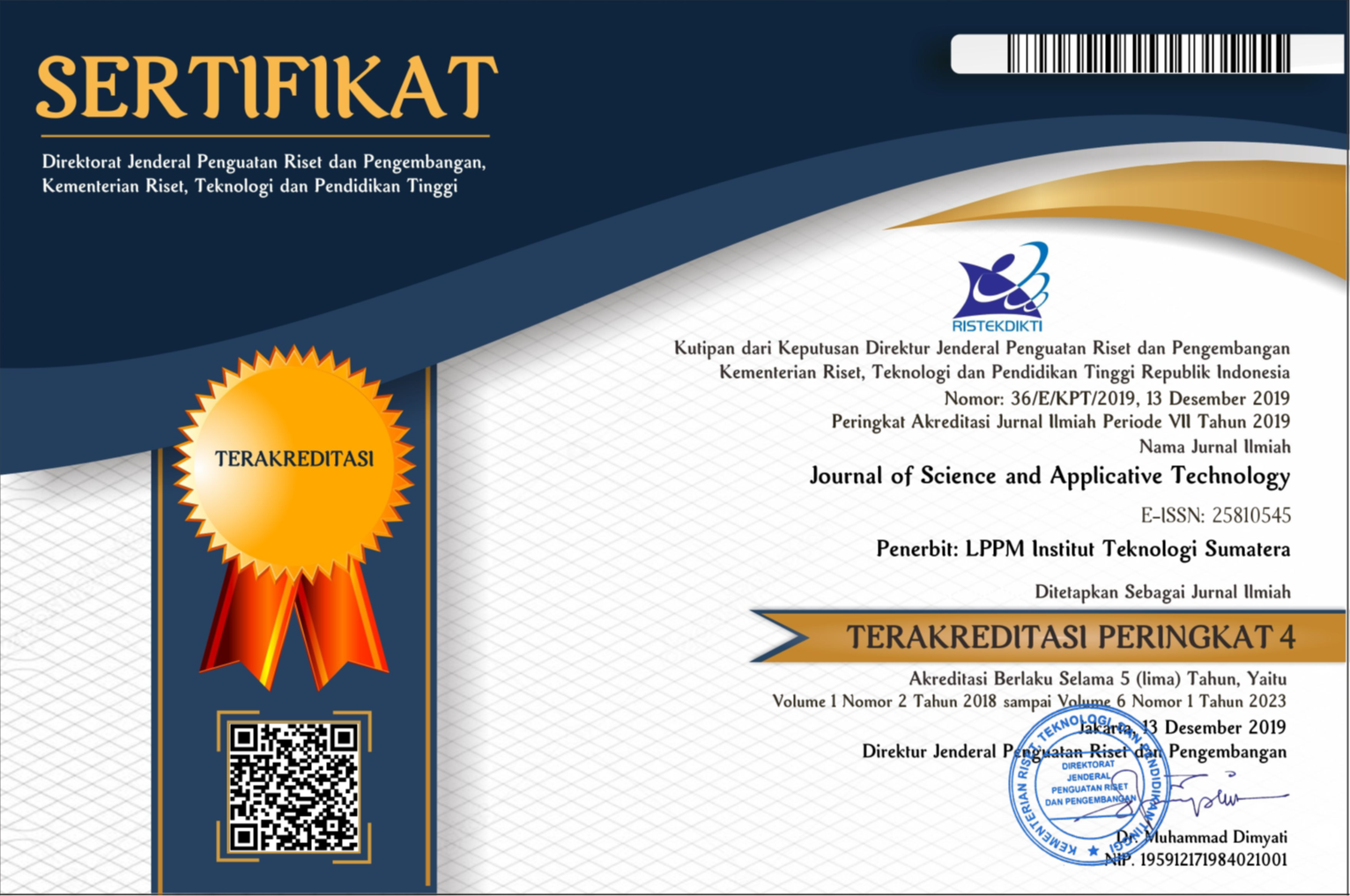Kebutuhan Lahan Pertanian Minimum untuk Kesejahteraan Petani di Pulau Sumatera
Abstract
The stream of sustainable city-region pinpoints the need to build an enhanced life support system. While it is expected to provide adequate foods for the current and future generation, the agriculture sector is, nevertheless, facing a challenge to sustain amidst the current massive urban sprawl. The study presents a case study of Western Indonesia, which is considered as one of the vast growing regions. The growth of urban centres creates a centrifugal force, resulting in a leapfrog development towards the outskirts, which usually causes the loss of prime agricultural lands. Existing planning documents were also unable to control the sprawling phenomenon, which impact at the current setback of farmers’ well-being. Previous studies show that the ability of peri-urban agriculture to accommodate self-provision of food and to ensure adequate income for farmers appear as the most prominent motivation which encourage farmers to stay engaged in farming sectors (Adrianto et al., 2013). Overall, this study uses qualitative analysis to investigate opportunities to preserve agriculture land by find out the requirement of agriculture land for farmer’s well being. This research comparing the minimum wage of each province in Sumatera and the income of farmers from agricultural production, so it is known that farmers on the island of Sumatra must have an average land area of 0.85 hectares to achieve welfare.
Downloads
References
[2] Milton, C. C. (2003) ‘Innovating Conservation Agriculture: The Case of No-Till Cropping’, Rural Sociology, 68(2), pp. 278–304.
[3] FAO (2015) The economic lives of smallholder farmers, Food and Agriculture Organization of the United Nations. Rome: United Nations. doi: 10.5296/rae.v6i4.6320.
[4] Parnell, S. and Oldfield, S. (2014) The Routledge Handbook on Cities of the Global South. London: Routledge. doi: 10.4324/9780203387832.
[5] Ayambire, R. A. et al. (2019). ‘A review of practices for sustaining urban and peri-urban agriculture: Implications for land use planning in rapidly urbanising Ghanaian cities’, Land Use Policy. Elsevier, 84(February 2018), pp. 260–277. doi: 10.1016/j.landusepol. 2019.03.004.
[6] Jabareen, Yosef Rafeq. (2006). Sustainable Urban Forms – Their typologies, Models and Concepts. Journal of Planning Education and Research. vol 26 \: 38-52
[7] Saxby, H., Gkartzios, M. and Scott, K. (2018) ‘“Farming on the Edgeâ€: Wellbeing and Participation in Agri-Environmental Schemes’, Sociologia Ruralis, 58(2), pp. 392–411. doi: 10.1111/soru.12180.
[8] Kumar, A. et al. (2020) ‘Access to credit and economic well-being of rural households: Evidence from Eastern India’, Journal of Agricultural and Resource Economics, 45(1), pp. 145–160. doi: 10.22004/ag.econ.298439.
[9] Lu, W. and Horlu, G. S. A. (2017) ‘Economic well-being of rural farm households in Ghana: A perspective of inequality and polarisation’, Journal of Rural Studies. Elsevier Ltd, 55, pp. 248–262. doi: 10.1016/j.jrurstud.2017.08.013.
[10] Ma, W. et al. (2020) ‘Impact of Internet use on economic well-being of rural households: Evidence from China’, Review of Development Economics, 24(2), pp. 503–523. doi: 10.1111/rode.12645.
[11] Sunderlin, W. D. et al. (2001) ‘Economic crisis, small farmer well-being, and forest cover change in Indonesia’, World Development, 29(5), pp. 767–782. doi: 10.1016/S0305-750X(01)00009-2.
[12] Kosanlawit, S., Soni, P. and Shivakoti, G. P. (2017) ‘The relationship between effective and equitable water allocation, local rice farmer participation and economic well-being: Insights from Thailand’s Chiang Mai Province’, Water (Switzerland), 9(5). doi: 10.3390/w9050319.
[13] Magala, D. B., Najjingo Mangheni, M. and Miiro, R. F. (2019) ‘Actor social networks as knowledge sharing mechanisms in multi-stakeholder processes: a case of coffee innovation platforms of Uganda’, Journal of Agricultural Education and Extension. Taylor & Francis, 25(4), pp. 323–336. doi: 10.1080/1389224X.2019.1629971.
[14] Markussen, T. et al. (2018) ‘The Happy Farmer: Self-Employment and Subjective Well-Being in Rural Vietnam’, Journal of Happiness Studies. Springer Netherlands, 19(6), pp. 1613–1636. doi: 10.1007/s10902-017-9858-x.
[15] Väth, S. J., Gobien, S. and Kirk, M. (2019) ‘Socio-economic well-being, contract farming and property rights: Evidence from Ghana’, Land Use Policy. Elsevier, (81 April 2017), pp. 878–888. doi: 10.1016/j.landusepol.2017.04.023.
[16] Puddu M., Bartolini F., Viaggi D. (2012). Simulation of Land Use and Investment Behaviour under Different Policy Scenarios. Factor Markets. Working Paper, No. 27, July 2012, 30 p.
[17] Nipers, A., Pilvere , I., Krievina, A. (2015). Sizes Of Farmland Necessary For Earning Minimum Income and Investment Required For Farms Of Various Specializations In Latvia. Engineering For Rural Development Jelgava, 20.-22.05.
[18] Latruffe, L. and Piet, L. (2014) ‘Does land fragmentation affect farm performance? A case study from Brittany, France’, Agricultural Systems. Elsevier Ltd, 129, pp. 68–80. doi: 10.1016/j.agsy.2014.05.005.
[19] The Business Line (2018) ‘Average farm landholding size shrinks to 1.1 ha’, Agri Business, 17 August. Available at: https://www.thehindubusinessline.com/economy/agri-business/average-farm-landholding-size-shrinks-to-11-ha/article24719240.ece.
[20] Pochanasomboon, A., Attavanich, W. and Kidsom, A. (2020) ‘Impacts of Land Ownership on the Economic Performance and Viability of Rice Farming’, Land, 9(71), pp. 1–18.
[21] Centre of Statistical Bureau of the Republic of Indonesia. (2013). Analysis of Food Crops Business Households in Indonesia from Agricultural Census 2013
[22] Susilowati, S. H. and Maulana, M. (2012) ‘Farm Business Land Size and Farmers Welfare: Smallholders Existence and Agrarian Reform Urgency’, Analisis Kebijakan Pertanian, 10(1), pp. 17–30.
[23] Centre of Statistical Bureau of the Republic of Indonesia. (2019). Executive Summary of Rice Harvest and Production Areas in Indonesia 2019
[24] Centre of Statistical Bureau of the Republic of Indonesia. (2019). Price Statistics of Grain Producers in Indonesia 2019
[25] Irawan, B., Purwoto, A., Saleh, C., Supriatna, A., & Kirom, N. A. (2000). Pengembangan Model Kelembagaan Reservasi Lahan Pertanian. Pusat Penelitian Sosial Ekonomi Pertanian Badan Penelitian dan Pengembangan Pertanian Departemen Pertanian. Bogor.
[26] Undang-Undang No. 41 Tahun 2009 Tentang Perlindungan Lahan Pertanian Pangan Berkelanjutan
[27] Adrianto, D. W., Aprildahani, B. R., Subagiyo, A. (2012). Tackling the Sprawl, Protecting the Parcels – an Insight to the Community’s Preference on Peri-Urban Agricultural Preservation. Spaces and Flows: An International Journal of Urban and ExtraUrban Studies.
[28] Centre of Statistical Bureau of the Republic of Indonesia. (2017). Survey Result of Paddy Cultivation Cost Structure 2017
[29] Peraturan Pemerintah tentang Tenaga Kerja dan Transmigrasi No. 13 Tahun 2012
[30] Centre of Statistical Bureau of the Republic of Indonesia. (2020). Indonesia Statistics 2020
Copyright (c) 2021 Journal of Science and Applicative Technology

This work is licensed under a Creative Commons Attribution-NonCommercial 4.0 International License.
All the content on Journal of Science and Applicative Technology (JSAT) may be used under the terms of the Creative Commons Attribution-NonCommercial 4.0 International License.
You are free to:
- Share - copy and redistribute the material in any medium or format
- Adapt - remix, transform, and build upon the material
Under the following terms:
- Attribution - You must give appropriate credit, provide a link to the license, and indicate if changes were made. You may do so in any reasonable manner, but not in any way that suggests the licensor endorses you or your use.
- NonCommercial - You may not use the material for commercial purposes.
- No additional restrictions - You may not apply legal terms or technological measures that legally restrict others from doing anything the license permits.





















